Giving and receiving feedback is an essential part of personal development and professional growth. It is a powerful tool that can help individuals improve their performance, build stronger relationships, and achieve their goals.
However, it can be challenging to provide constructive criticism without hurting someone’s feelings or damaging positive relationships. In this post, we will explore 45 negative feedback examples that are not only effective but also respectful and non-offensive.
By the end of this article, you will be equipped with the knowledge and tools necessary to navigate the delicate art of giving negative feedback that promotes growth and fosters understanding.
Key Takeaways:
👉 Negative feedback can be a powerful tool for improvement when presented constructively.
👉 Four types of negative feedback: Evaluative, Directive, Coaching, and Expert.
👉 People focus more on negative feedback, so be clear and encouraging when delivering it.
👉 Explore Peoplebox for a free demo and learn more about building a feedback-driven culture.

What is Negative Feedback?
Negative feedback involves sharing information about an employee’s performance, behavior, or actions to identify areas for improvement or change. This type of feedback can be critical for personal and professional development as it offers insights into what can be enhanced or altered to achieve better results.

Keep in mind that constructive feedback gains validity when supported by data. Setting goals is a key way to ensure you have the necessary data. With Peoplebox’s performance management platform, managers can seamlessly provide goal-based feedback, ensuring negative feedback is data-driven rather than arbitrary.
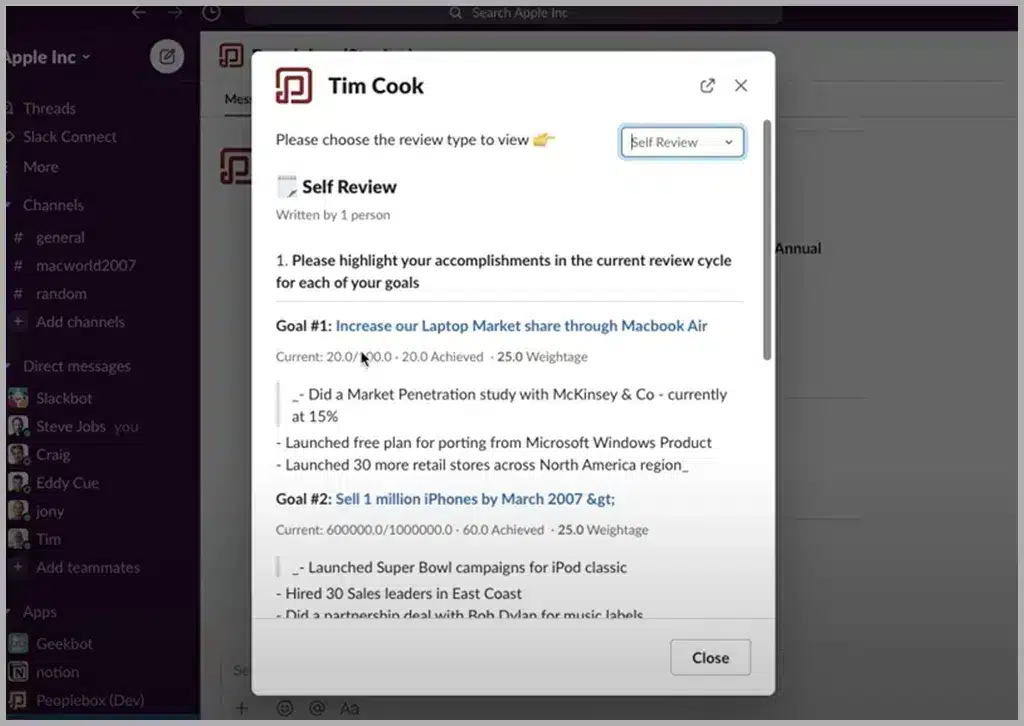
As Chappelow and McCauley write in the Harvard Business Review,
“An insightful critique provides a chance to grow and excel.”
However, the effectiveness of critical feedback lies not just in its delivery but in the manner in which it is provided. That’s where constructive feedback comes into play.
Let’s take an example to understand this better.

Imagine a scenario in which a project manager is tasked with giving feedback to a team member who has consistently missed deadlines. The manager has two approaches:
1️⃣ Constructive Feedback:
In this example of constructive feedback, the project manager chooses to provide negative feedback in a constructive manner. They schedule a one-on-one meeting with the team member and acknowledge the employee’s effort and dedication.
The manager then discusses the missed deadlines, constructively outlining the impact on the team and the project’s overall success. They collaborate with the team member to identify potential barriers and solutions, ultimately leading to positive changes.
The focus of constructive negative feedback is on improvement, growth, and support.

2️⃣ Destructive Feedback:
In contrast, the destructive approach of giving negative feedback involves the manager confronting the team member publicly, criticizing their consistent failures, and implying incompetence.
This approach does not offer any solutions or opportunities for improvement, instead undermining the individual’s self-esteem and causing frustration.
Here are a few other examples of how a negative feedback could have been said in a constructive way:
❌ This presentation is all over the place. Can you even organize your thoughts?
✅ The presentation has some great ideas, but I think it could be even stronger if we restructure the flow a bit. Would you be open to brainstorming ways to organize the content for a clearer message?
❌ You never listen in meetings! Why did you miss that important update?
✅ It seems like we may have missed connecting on a key update during the last meeting. Can you tell me what your understanding is of [specific update]?
❌ You’re constantly making careless mistakes. This is unacceptable!”
✅ I’ve noticed a few errors slipping through lately. Can we discuss some strategies to ensure accuracy? Perhaps implementing a double-checking process could be helpful.
❌ This report is late again! You need to manage your time better.
✅ I see the report is running a bit behind schedule. Is there anything I can do to help you meet the deadline? Do you have any specific resource needs?
The contrast between these two approaches illustrates the difference between constructive and destructive feedback.
Constructive feedback aims to build, empower, and develop, while destructive feedback diminishes, demotivates, and hinders progress.
Ashira Prossack, a prominent business communication coach, simplifies the feedback process into four key steps.
When engaging with underperforming employees, these steps can facilitate effective discussions. Begin by offering the critique. Then, clarify the implications it holds. Next, outline ways for improvement. Finally, confirm the employee’s understanding and encourage them to share their feedback.
This structured feedback approach ensures the employee grasps what’s required and allows them to seek further clarification or assistance.
What are the Four Types of Negative Feedback?
Negative employee feedback can take various forms in various situations, each with its unique approach and purpose. To help you navigate this terrain, we’ve defined four types of negative feedback, each playing a pivotal role in fostering employee development and driving organizational success.
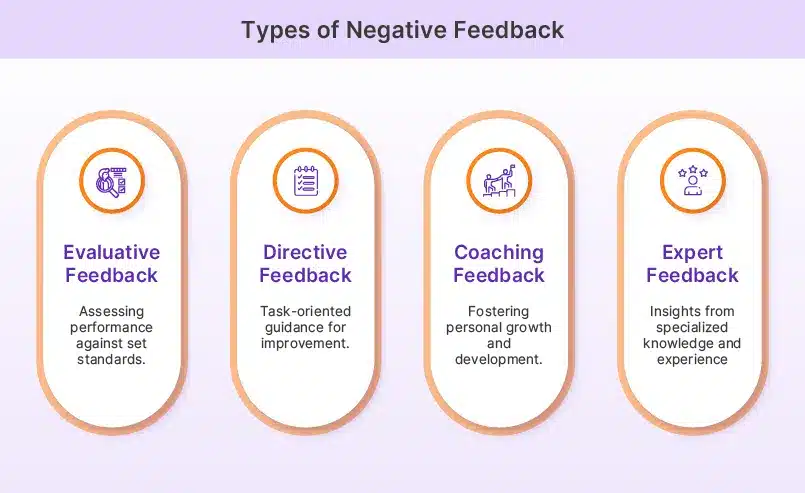
✅ Evaluative Feedback
Evaluative feedback involves assessing an employee’s performance based on set criteria or standards. It provides a clear perspective on an employee’s strengths and weaknesses and helps them understand how their performance measures up to expectations. Here are a few examples of evaluative feedback that are not offensive:
“Your attention to detail in your reports is outstanding, but we need to work on meeting deadlines consistently.”
“Your communication skills in meetings have improved significantly, and now let’s focus on enhancing your team collaboration.”
🗒️ Directive Feedback
Directive feedback is task-oriented and aims to guide employees in a specific direction or action. It often includes suggestions for improvement and actionable steps. Here are some directive feedback examples:
“To enhance your project management skills, consider using a project management software tool to track tasks more efficiently.”
“Let’s implement a more structured approach to your daily tasks to ensure you stay on track and meet deadlines.”
🗣️ Coaching Feedback
Coaching feedback focuses on employee development and growth. It encourages employees to reflect on their work performance and take ownership of their improvement. Here are a few coaching feedback examples:
“You’ve shown significant potential as a leader. Let’s work together on developing your leadership skills through mentoring and training.”
“I believe you have untapped potential. I encourage you to set specific career goals, and I’m here to support you in achieving them.”
👨💼 Expert Feedback
Expert feedback involves providing insights and guidance from someone with specialized knowledge or experience in a particular area. It can be particularly valuable in fields where expertise is essential. Examples of expert feedback include:
“As an expert in digital marketing, I recommend experimenting with A/B testing to optimize our online ad campaigns.”
“In my experience, using agile methodologies can greatly improve project efficiency. Let’s discuss how we can implement this approach.”
Now that we’ve covered the different types of negative performance feedback examples, it’s vital to explore a significant psychological phenomenon that profoundly influences our perceptions and interactions—negativity bias. Why? Read to find out.
What Is Negativity Bias, And Why Should You Care?
Negativity bias refers to the human tendency to give more weight to negative information and experiences than to positive ones.
In other words, we are more likely to notice, remember, and be influenced by negative events, feedback, or criticism, even when they are outnumbered by positive experiences.
The Impact of Negativity Bias on Performance Management
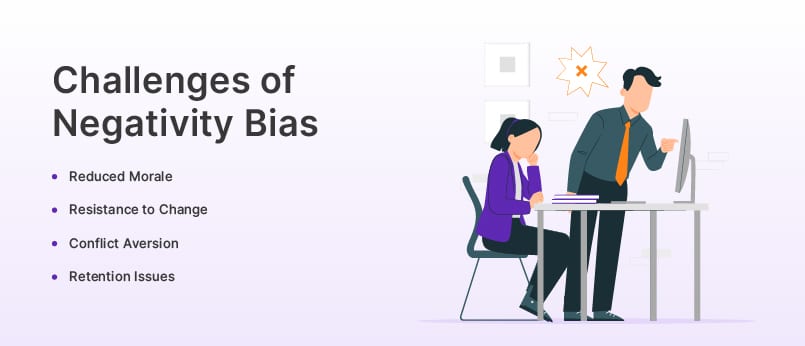
🔻 Reduced Morale: Employees may become demotivated or disheartened when they focus on negative feedback, which can lead to a decline in their morale and productivity.
❌ Resistance to Change: Negativity bias can make employees resistant to change initiatives, as they may perceive them as negative developments.
🏃 Conflict Aversion: Managers may avoid giving negative feedback altogether, fearing negative reactions, which can hinder professional growth and development.
👋 Retention Issues: Employees who feel overwhelmed by negativity bias may become disengaged and consider leaving the organization.
In a nutshell, negativity bias influences not only employee well-being but also organizational success.
Recognizing and addressing this bias is an investment in the growth and development of the employees, which, in turn, leads to higher team performance and cultivates a more positive work environment.
If giving feedback feels daunting, here’s a secret: Peoplebox streamlines the process in just three steps:
Click on “Write Review”
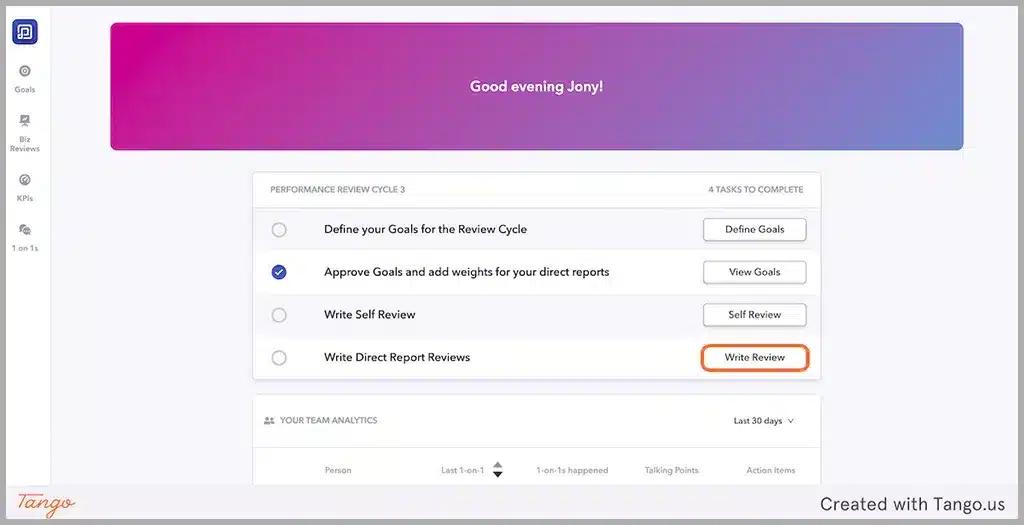
Select relevant review options by referring to the employee’s review on the right.
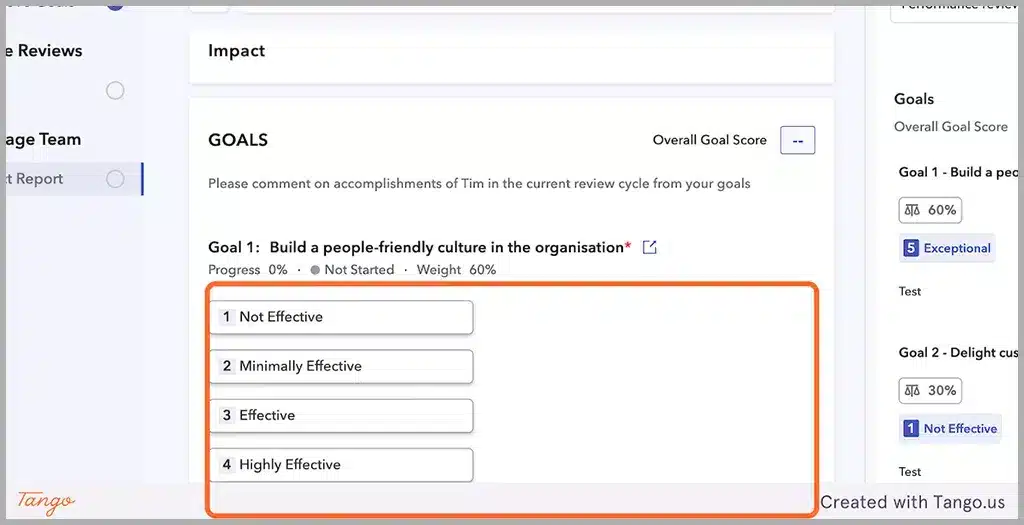
Click on Submit
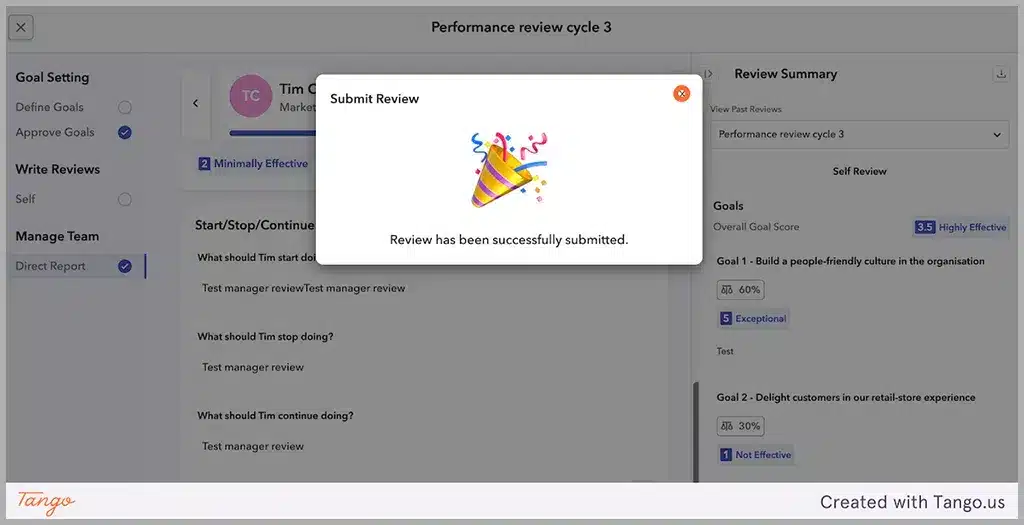
No more spending hours trying to write inefficient reviews!
Now that we’ve covered the basics of negative feedback, let us look at some examples of negative feedback your team can use to ensure a positive outcome.
❌ 45 Constructive Negative Feedback Examples
Giving negative feedback to employees is a delicate art that requires sensitivity and professionalism. Let’s now examine examples of negative feedback across various scenarios.
1️⃣ Example of Negative Performance Feedback
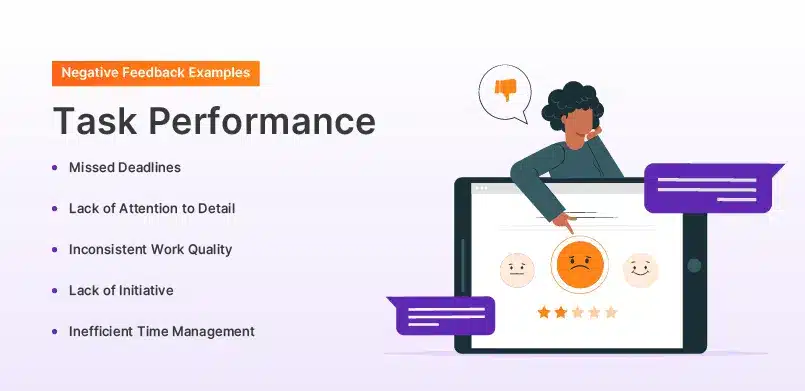
📅 Missed Deadlines
“I’ve noticed that you’ve been missing deadlines. It affects our overall productivity, and I believe that you can do better. To improve, let’s work on setting more realistic schedules and sticking to them.”
🗒️ Lack of Attention to Detail
“There are times when your work lacks attention to detail. To get better, I’d appreciate it if you could review your tasks more thoroughly for errors before you submit them.”
🆗 Inconsistent Work Quality
“Your work quality seems to vary. I believe in your potential, and I’d like to see you aim for consistency by maintaining high standards in all tasks.”
👍 Lack of Initiative
“I’ve noticed that you tend to wait for instructions rather than taking the initiative. To grow in your role, let’s work on initiating tasks on your own and identifying areas that need attention.”
⌛ Inefficient Time Management
“It appears that your time management needs some improvement. I believe you can do better by trying a time-tracking system to meet deadlines more consistently.”
2️⃣ Constructive Negative Feedback Examples on Communication Skills
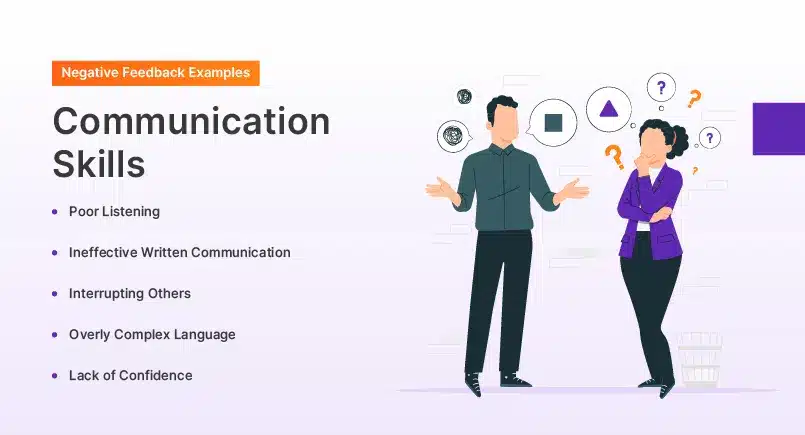
👂 Poor Listening
“I’ve received feedback that you might not always be fully engaged during meetings. Improving your active listening skills would benefit your communication.”
✍️ Ineffective Written Communication
“Sometimes, your written communication could be clearer. I’d appreciate it if you could focus on making your emails concise and well-structured.”
🗣️ Interrupting Others
“There are times when it feels like you’re eager to jump in during discussions. Let’s give others a chance to finish their thoughts before responding.”
📚 Overly Complex Language
“Your use of jargon can be overwhelming. I think that we’d communicate more effectively if you aim for a clear and straightforward language that everyone can understand.”
😞 Lack of Confidence
“You’re doing great, but I’ve noticed that you sometimes appear unsure in your presentations. Building your confidence through practice and thorough preparation would make a significant difference.”
3️⃣ Negative Feedback Examples on Interpersonal Skills

🏃 Conflict Avoidance
“I’ve noticed that you sometimes avoid addressing conflicts with colleagues. Confronting issues openly and finding solutions together is crucial for team dynamics.”
👿 Insensitivity to Others’ Feelings
“There have been instances where your comments came across as a bit insensitive. Being more mindful of your colleagues’ emotions and feelings would ensure healthy relationships.”
😏 Poor Team Player
“You’re a valuable team member, but sometimes it feels like you prioritize personal goals over team objectives. Let’s work on nurturing a more collaborative spirit and supporting your colleagues.”
🫦 Gossiping
“Gossiping in the office doesn’t contribute to a positive work environment. Shifting your focus towards more constructive and professional conversations would be appreciated.”
❌ Resistance to Feedback
“In the past, you’ve seemed a bit resistant to feedback. Embracing constructive criticism as a way to grow is essential.”
4️⃣ Negative Reviews Examples on Time Management
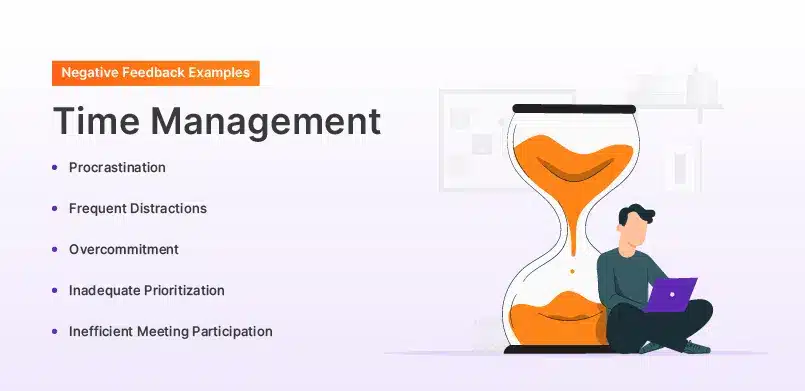
🛌 Procrastination
“Procrastination affects all of us at times. Creating a structured schedule and breaking tasks into manageable steps would help you overcome this habit.”
🦋 Frequent Distractions
“Distractions can get the best of us sometimes. Let’s work together to identify and minimize distractions during your work hours.”
💯 Overcommitment
“You’re quite enthusiastic, but overcommitting can lead to burnout. Let’s work on saying ‘no’ when necessary and managing your workload effectively.”
🧾 Inadequate Prioritization
“Prioritizing tasks can be a challenge for everyone. Getting better at distinguishing between urgent and important responsibilities to meet those deadlines would be a great focus.”
😪 Inefficient Meeting Participation
“Our meeting time could be used more productively. Let’s see you prepare for meetings in advance and actively engage in discussions to make the most of your time.”
5️⃣ Negative Feedback Examples on Addressing Conflict

🏃 Avoiding Difficult Conversations
“Addressing difficult conversations is something we all need to work on. Let’s be more open about your concerns and work together to find solutions.”
🤬 Aggressive Communication
“We all get passionate sometimes, but it’s important to keep our communication respectful and diplomatic. Giving that a try would be appreciated.”
👹 Holding Grudges
“Holding onto grudges doesn’t really help anyone. Let’s work on letting go of past grievances and focus on finding resolutions instead.”
🤸 Inflexibility
“Being flexible in your views can open up new possibilities. Let’s work on being open to compromise and considering alternative solutions.”
🫶 Lack of Empathy
“Showing empathy during conflicts can make problem-solving easier. Let’s try putting yourself in the other person’s shoes to find common ground.”
6️⃣ Negative Leadership Feedback Examples

🔬 Micromanagement
“I know it’s sometimes tough, but micromanagement can stifle our team’s autonomy. I believe in your potential, and I’d like to see you trust our team’s abilities and delegate more effectively.”
📊 Inconsistent Leadership
“Consistency in leadership is something we all appreciate. Providing clear guidance by making your decision-making and communication more consistent would be beneficial.”
🎯 Lack of Vision
“You’re doing a great job, but a clear vision can guide us even further. Let’s work on developing an inspiring vision for our team together.”
🥇 Failure to Recognize Achievements
“Acknowledging our team’s achievements can be motivating. Making it a habit to recognize and appreciate their hard work would be great.”
😏 Poor Delegation
“You’ve got a lot on your plate, but delegating effectively will free up your time and help our team grow. Let’s work on mastering the art of delegation.”
7️⃣ Negative Feedback Examples on Motivation
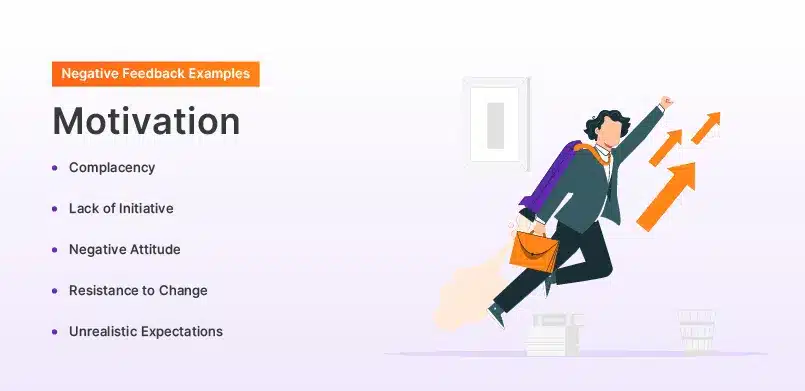
🥱 Complacency
“You know, we all have those moments when we get a little too comfortable. I’d really like to see you challenge yourself with new opportunities and set some higher goals to keep your motivation alive.”
😶 Lack of Initiative
“I’ve noticed that taking the initiative could lead to personal growth. How about you take ownership of your career and actively seek opportunities for self-improvement?”
😑 Negative Attitude
“I believe that a positive attitude is contagious. It’d be great to see you work on maintaining an optimistic outlook and creating a workplace filled with positivity.”
🙅 Resistance to Change
“Change is a part of life, and it can be an opportunity for growth. I’d really appreciate it if you could embrace change and adapt to new situations with enthusiasm.”
🎯 Unrealistic Expectations
“I think setting realistic goals can lead to a more sustainable motivation. Let’s focus on achievable goals and learn to appreciate your progress along the way.”
8️⃣ Negative Feedback Examples on Problem-solving
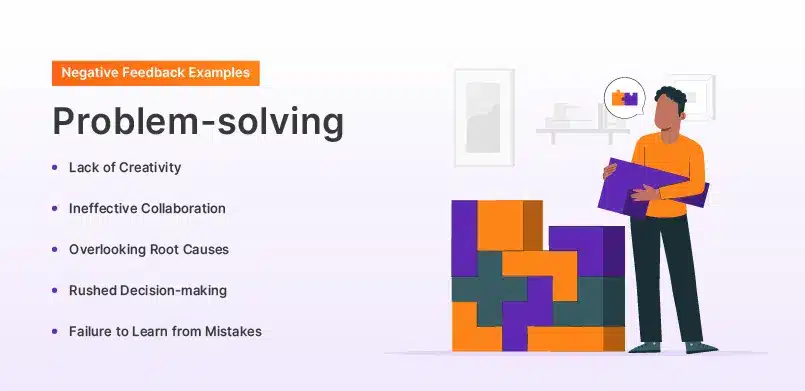
📦 Lack of Creativity
“You know, we all have our unique ways of approaching problems. But sometimes, a little creativity can go a long way. I’d love to see you encourage innovative thinking and explore diverse solutions.”
😏 Ineffective Collaboration
“Collaboration is key when it comes to solving complex problems. How about we work on enhancing your teamwork and coordination skills to tackle challenges more effectively as a team?”
🫚 Overlooking Root Causes
“It’s quite common to overlook the root causes of problems. I’d appreciate it if you could dig a bit deeper to identify those underlying issues, so we can find more effective solutions.”
⏲️ Rushed Decision-making
“We all make hasty decisions from time to time, which might not always be the best ones. How about we try taking a bit more time to consider various options and their implications?”
⛔ Failure to Learn from Mistakes
“Mistakes happen to the best of us. It’s not just about acknowledging them but also learning and growing from them. I’d like to see that from you.”
9️⃣ Negative Feedback Examples on Attitude & Behavior

⌛ Punctuality Issues
“Being on time is something we can all work on, and I’d really appreciate it if you could commit to punctuality. It helps maintain a respectful and efficient work environment.”
😡 Negativity in the Workplace
“We all have our tough days, but fostering positivity in the workplace is important. I’d like to see you focus on maintaining a positive and constructive attitude at work.”
😝 Disregard for Company Policies
“Company policies are there for a reason, and I’d like to see you make an effort to familiarize yourself with and adhere to the organization’s rules and regulations.”
🏃 Lack of Accountability
“Taking responsibility for our actions is vital for the team. I’d really appreciate it if you could acknowledge your mistakes and work with us to build trust within the team.”
🤯 Ineffective Stress Management
“Stress is a part of life, but managing it effectively can improve our performance and well-being. I’d like to see you implement stress-relief techniques and maintain a healthy work-life balance.”
❌ Negative Feedback Examples to Managers From Their Employees
Managers play a pivotal role in shaping an organization, but they are not infallible. Employees often have valuable insights and observations that can help managers improve and make better decisions.
To illustrate the art of providing feedback effectively, let’s consider a scenario involving a manager’s leadership style:
Negative Employee Feedback to Manager Example 1
Wrong Way to Give Feedback:
“You’re a terrible leader. Your decisions are always wrong, and you don’t inspire us.”
This approach is overly critical, vague, and offers no guidance for improvement.
Right Way to Give Feedback:
“I’ve observed that some team members have expressed uncertainty about the decision-making process, and there is room for improvement in aligning our team’s goals. It might be helpful if we could implement more regular team meetings to foster a more collaborative approach and transparency in our decision-making.
Additionally, your insights, critical thinking, and guidance could inspire us to reach our full potential if they were communicated more consistently.”
This approach is specific, factual, and provides actionable suggestions for enhancing leadership and team dynamics.
Negative Employee Feedback to Manager Example 2
Wrong Way to Give Feedback:
“You always delegate tasks unfairly. It’s like you’re playing favorites, and it’s demotivating.”
This approach makes broad accusations without specific examples and doesn’t provide a clear path to improvement.
Right Way to Give Feedback:
“I’ve noticed that task assignments seem uneven at times, which can impact team morale. To address this, could we consider implementing a more transparent task allocation process, perhaps through rotating responsibilities or discussing expectations openly during team meetings?”
This approach highlights the issue, provides a constructive solution, and invites a collaborative discussion on how to improve delegation practices.
⌛ When to Give Feedback to Your Manager
Giving feedback to your manager should be a thoughtful process. Here are some key situations where it is appropriate to provide feedback:
1. Regular Feedback Sessions: Many organizations encourage regular one-on-one meetings with managers precisely for this purpose. This is a safe and structured opportunity to share your thoughts and concerns.
2. When It Impacts Your Work: If a particular issue directly affects your productivity, job satisfaction, or well-being, it’s essential to discuss it with your manager.
3. After Critical Incidents: When a specific incident or event occurs, and you believe it warrants discussion or improvement, it’s a good time to provide feedback.
4. When You Can Suggest Solutions: Constructive feedback becomes even more valuable when you can suggest potential solutions to the problem.
👀 How to Give Feedback to Your Manager?
Providing feedback to your manager requires a delicate approach to ensure it is well-received. Here are the steps to follow when giving feedback:
1. Choose the Right Time and Place: Find a suitable time and location for the conversation, ensuring privacy and a comfortable atmosphere.
2. Be Specific and Factual: State the issue clearly and provide specific examples. Use facts, not emotions, to convey your message.
3. Use “I” Statements: Express your observations and feelings with “I” statements, such as “I noticed,” “I felt,” to avoid sounding accusatory.
4. Offer Constructive Criticism: Instead of just highlighting the problem, suggest possible solutions or improvements.
5. Listen Actively: Encourage your manager to respond and engage in a constructive dialogue. Listening is a crucial part of effective feedback.
6. Follow Up: After discussing the issue, make a plan with your manager to address it and establish a timeline for follow-up.
Now that we’ve discussed how to deliver negative feedback, it’s equally important to address the other side of the equation: how to handle negative feedback when you’re on the receiving end.
🙉 How to Professionally Respond to Negative Feedback?
Negative feedback, whether it comes from a supervisor, a peer, or a customer, can be a tough pill to swallow. However, it’s a critical aspect of personal and professional growth. Let’s look at examples of how to effectively handle negative feedback, turning it into an opportunity for improvement and development.
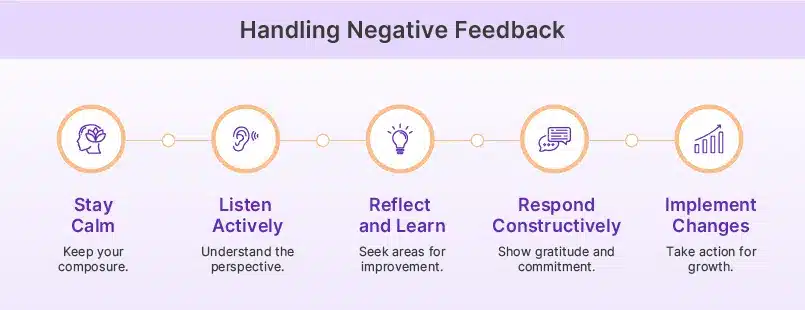
✅ Acknowledge and Express Appreciation:
Negative Feedback Example: “Your presentation lacked clarity and was hard to follow.”
Response: “Thank you for your feedback. I appreciate your honesty and will work on making my presentations more clear and engaging.”
✅ Seek Clarification:
Negative Feedback Example: “Your project report contained errors.”
Response: “I appreciate your feedback. Can you please point out the specific errors so I can address them?”
✅ Apologize and Commit to Improvement:
Negative Feedback Example: “You missed an important deadline on the project.”
Response: “I’m sorry I missed the deadline. I take full responsibility for it and will ensure it doesn’t happen again.”
✅ Express Willingness to Learn:
Negative Feedback Example: “Your communication issues with the team needs improvement.”
Response: “Thank you for letting me know. I’m always eager to learn and improve. Could you provide some guidance on how I can communicate better?”
✅ Show Gratitude and Share an Action Plan:
Negative Feedback Example: “Your customer service has been lacking in responsiveness.”
Response: “I’m grateful for your feedback. To improve our service, we will enhance our response times and ensure better communication with our customers. Thank you for helping us get better.”
Creating a Constructive Feedback Culture with Peoplebox
In today’s dynamic business environment, fostering a company culture of constructive feedback and employee engagement is crucial for organizational growth. This is where Peoplebox emerges as an indispensable ally.
With features like 1:1 meetings, regular check-ins, insightful surveys, and in-depth performance reviews, HR teams can build a culture of continuous feedback.

Our team of HR specialists and people scientists have meticulously curated ready-to-use templates for you to use, or you can build your employee questionnaires from scratch for various purposes, such as
👉🏼 OKRs and goal-setting
👉🏼 Performance discussions
👉🏼 1:1 talking points
👉🏼 360-degree reviews
👉🏼 Employee engagement surveys, etc.
Moreover, we offer white-glove support to train managers and administrators to ensure that your employees not only appreciate reviews but enthusiastically embrace the entire feedback ecosystem.
With Peoplebox, your organization not only unlocks the potential for enhanced employee development but also paves the way for a culture where constructive feedback becomes the norm.
If you’re ready to transform performance management, book a demo with Peoplebox and take the first step towards an engaged and productive workforce.








